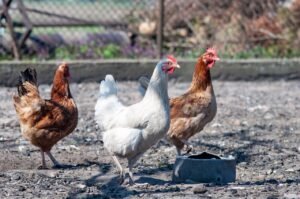
During the scorching summer months, ensuring the well-being of your chickens becomes a top priority. As temperatures rise, the risk of heat stress and heatstroke becomes a grave concern. But fret not, because we’ve got you covered! In this article, we will explore effective strategies and useful tips on safeguarding your feathered friends from the sweltering heat. With a little care and attention, you can keep your flock cool, comfortable, and thriving throughout the hottest days of the year. So, let’s dive in and discover how you can protect your chickens from the perils of heat stress and heatstroke!

Factors contributing to heat stress and heatstroke in chickens
High temperatures
High temperatures are one of the main contributors to heat stress and heatstroke in chickens. When the ambient temperature rises above a certain threshold, usually around 85°F (29.4°C), chickens struggle to cool their bodies effectively. This can lead to increased panting and discomfort, putting them at risk of developing heat stress or heatstroke.
Humidity
Humidity exacerbates the effects of high temperatures on chickens. When the air is humid, it becomes more difficult for chickens to cool themselves through evaporation. The moisture in the air prevents effective evaporation from their respiratory system and skin, making it harder for them to dissipate heat. As a result, chickens are more susceptible to heat stress and heatstroke in humid conditions.
Poor ventilation
Insufficient airflow in the chicken coop can contribute to heat stress and heatstroke. Without proper ventilation, hot air accumulates, trapping heat inside the coop. This stagnant air prevents the exchange of fresh, cool air, leading to an increase in temperature. It is crucial to provide adequate ventilation to ensure that warm air is replaced with cooler air, helping chickens regulate their body temperature and avoid heat-related issues.
Recognizing heat stress and heatstroke in chickens
Signs of heat stress
It is important to be able to recognize the signs of heat stress in chickens. Some common signs include excessive panting, spread wings, droopy combs, pale faces, and lethargy. Chickens experiencing heat stress might also reduce their food intake and exhibit increased water consumption. If you notice any of these signs, it is essential to take immediate action to prevent the situation from escalating to heatstroke.
Symptoms of heatstroke
Heatstroke is a severe condition that can be life-threatening for chickens. If heat stress is not alleviated, it can progress to heatstroke. Some symptoms of heatstroke include open-mouthed breathing, rapid breathing, unresponsiveness, convulsions, and even death. It is crucial to act quickly if you suspect a chicken is suffering from heatstroke and seek veterinary assistance as soon as possible.

Providing adequate water and electrolytes
Ensuring access to cool water
One of the most effective ways to protect chickens from heat stress and heatstroke is by ensuring they have access to cool water at all times. During hot weather, water sources should be replenished frequently and kept in shaded areas to prevent them from becoming too warm. You can also consider using automatic poultry waterers that release cool water periodically, ensuring a constant supply for your chickens.
Adding electrolytes to drinking water
In addition to providing cool water, adding electrolytes to your chickens’ drinking water can help them maintain hydration and electrolyte balance during hot weather. Electrolyte supplements are available specifically for poultry and can be easily mixed with water according to the manufacturer’s instructions. These supplements contain essential minerals and nutrients that support chickens’ overall health and aid in their ability to cope with heat stress.
Creating a comfortable environment
Shade and shelter
To protect chickens from heat stress, it is crucial to provide them with plenty of shade and shelter options. Natural shade from trees or artificial shades, such as tarps or umbrellas, can help create cooler areas in the chicken coop and run. Additionally, it is essential to ensure that the coop itself offers adequate protection from direct sunlight by positioning it in a shaded area or providing a roof that minimizes heat absorption.
Proper ventilation
Promoting proper ventilation is vital to maintaining a comfortable environment for chickens. Ample airflow helps remove heat and humidity from the coop, allowing fresh, cooler air to circulate. This can be achieved by strategically placing windows, vents, or fans in the coop. Cross ventilation, where air enters from one side and exits from the other, is particularly effective in preventing heat buildup.
Reducing crowding
Overcrowding in the chicken coop can worsen the effects of heat stress. The combination of increased body heat from numerous chickens and restricted airflow due to limited space can contribute to a higher risk of heat-related issues. Providing enough space for each chicken will help alleviate heat stress and reduce the chances of heatstroke. Aim for at least 4 square feet of floor space per chicken to ensure adequate ventilation and comfort.

Adjusting feeding routine
Feeding during cooler periods
To minimize heat stress, it is advisable to adjust the feeding routine for chickens during hot weather. Chickens have a higher metabolic rate when digesting food, which generates additional body heat. By feeding chickens during the cooler parts of the day, such as in the morning or evening, you can help reduce the heat produced during digestion. This allows chickens to focus on cooling themselves rather than generating excess heat internally.
Using cooling feed additives
Another strategy to mitigate heat stress is to incorporate cooling feed additives into chickens’ diet. These additives often contain natural ingredients like mint or eucalyptus, which are known for their cooling properties. Cooling feed additives can help lower chickens’ body temperature and improve their overall comfort during hot weather. Follow the manufacturer’s instructions for dosage and duration of use.
Managing the coop and bedding
Using reflective materials for the coop
Choosing reflective materials for the construction of the coop can help reduce heat absorption. Light-colored or reflective roofs and walls can reflect a significant amount of solar radiation, preventing excessive heating inside the coop. Additionally, using insulation materials specifically designed to reflect heat can further enhance the coop’s ability to maintain a comfortable temperature.
Choosing appropriate bedding
The type of bedding used in the coop can also affect heat stress levels in chickens. It is best to avoid bedding materials that retain heat, such as straw or wood shavings. Instead, opt for materials like sand or wood pellets that do not absorb as much heat. Bedding should also be kept clean and dry to prevent the growth of bacteria or fungi that can exacerbate heat stress.
Monitoring and adjusting ambient temperature
Using fans or misting systems
Installing fans or misting systems in the chicken coop can help lower the ambient temperature and provide relief for chickens. Fans create air movement, promoting evaporation and cooling, while misting systems release a fine mist of water droplets that evaporate quickly, reducing the surrounding temperature. It is important to position fans or misters in areas where chickens spend the most time, ensuring maximum cooling effect.
Installing temperature alarms
To effectively monitor the ambient temperature inside the chicken coop, consider installing temperature alarms. These devices can alert you if the temperature rises above a certain threshold, allowing you to take immediate action to protect your chickens. Temperature alarms can be set to trigger notifications via smartphone or audible alarms, ensuring that you are promptly notified of any dangerous temperature spikes.
Applying heat stress prevention techniques during transportation
Minimizing travel during hot weather
Transporting chickens during extreme heat can pose significant risks to their health. Whenever possible, it is best to avoid transporting chickens during excessively hot weather conditions. If transportation is unavoidable, choose cooler periods of the day and plan the route to minimize exposure to direct sunlight. Additionally, take necessary precautions to ensure the vehicle is properly ventilated to maintain a comfortable temperature during transport.
Ensuring proper ventilation in transport vehicles
Providing adequate ventilation in transport vehicles is crucial to prevent heat stress and heatstroke during transportation. Ensure that there are enough openings, such as windows or vents, to promote airflow and exchange of fresh air. Avoid overcrowding the transport vehicle to allow for better air circulation. Regularly check the temperature inside the vehicle and make adjustments as needed to maintain a safe and comfortable environment for the chickens.
Implementing strategies for broilers and layers
Reducing lighting intensity for broilers
Reducing the lighting intensity in broiler houses can help minimize heat stress in these fast-growing chickens. Lowering the overall light intensity by using dimmer switches or specific lighting fixtures for broilers can help regulate their body temperature. This approach allows broilers to conserve energy and reduces the heat generated by intense lighting, contributing to a more comfortable environment for them.
Providing elevated roosts for layers
Layers benefit from having elevated roosts in the chicken coop, especially during hot weather. Elevated roosting platforms provide better airflow and allow chickens to perch at a higher position, away from the ground where heat can accumulate. This elevation allows air to circulate beneath the layers, helping to dissipate heat and maintain a cooler body temperature.
Seeking veterinary advice and support
Consulting a veterinarian for guidance
If you notice any signs of heat stress or suspect that your chickens might be at risk of heatstroke, it is important to seek professional advice from a veterinarian. A veterinarian with experience in poultry health can provide guidance tailored to your specific situation. They can assess the overall health of your chickens, recommend preventive measures, and advise on emergency treatment if necessary.
Administering emergency treatment as advised
In cases of severe heat stress or heatstroke, immediate action is crucial. A veterinarian may provide specific instructions on how to administer emergency treatment to alleviate the condition and stabilize the affected chicken. Emergency treatments may include cooling methods, such as immersing the chicken in cool water or applying cold packs, and administering supportive care to address dehydration and electrolyte imbalances. Always follow the veterinarian’s advice carefully and monitor the chicken closely during the recovery process.
By implementing these strategies and staying vigilant, you can effectively protect your chickens from heat stress and heatstroke. Remember to prioritize their well-being by providing adequate water and electrolytes, creating a comfortable environment, adjusting feeding routines, managing the coop and bedding, monitoring ambient temperature, implementing heat stress prevention techniques during transportation, and seeking veterinary advice when needed. With these measures in place, you can ensure that your chickens stay healthy and resilient even during periods of high heat.







